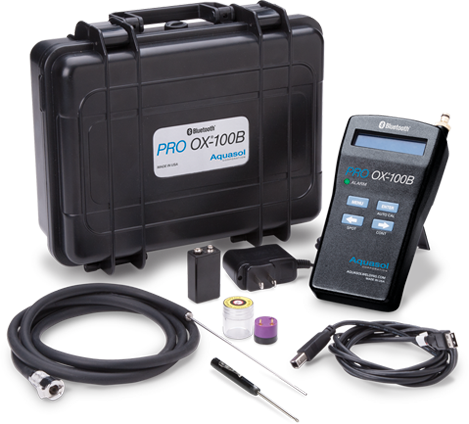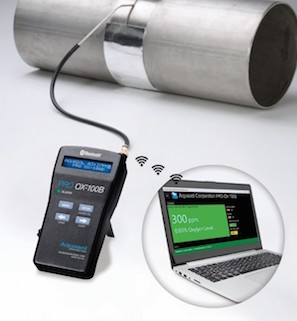Many welders and manufacturers take for granted the quality of their instruments: after all, it should be easy enough to generate an accurate measurement of something like oxygen levels, right? This assessment assumes that an individual instrument’s accuracy is correlated to its resolution. If this were the case, any ordinary oxygen monitor with the capability of measuring down to 100 ppm would be able to do so with a minimal degree of error. However, resolution is irrelevant to the accuracy of any given tool. The more precise a job needs to be, the further the degree of error must shrink. This is why you wouldn’t find the same measuring tools used in elementary school math classes as you would in professional industrial environments.
To account for the high degree of quality necessary for professional tools, independent standards have been developed for virtually every possible technology. These standards are generated by large national and international organizations with the intention of codifying rules for all possible uses of a tool. The many diverse uses of measuring tools makes this process painstaking; every manufacturer of an instrument must agree that the standards match their unique perspective on what the instrument should be able to do.
Fortunately, some prestigious standards have become a symbol of trust for consumers everywhere to ensure the quality of a product. The European Standards (EN) are among the most widely utilized of all standards, especially for electrical measuring devices. These standards are created and refined through a consensual process that involves all interested parties. The standards are then ratified by one of three European standards organization: CEN, CENELEC or ETSI. If one of these organizations ratifies a standard, it immediately becomes the national standard for all members in the European Union. These standards carry weight internationally too; the compulsory ratification in the EU influences manufacturers on a global scale to adhere to their mandates.
This is why Aquasol Corporation takes great pride in the fact that their PRO OX-100  and PRO OX-100B handheld oxygen monitors adhere to the EN 61326-1:2006 industrial standards for electrical measuring equipment. Not only are these products internationally renowned for their low cost and advanced features, but they pass the rigorous standards that welders expect. For example, Aquasol utilizes 2-point calibration to improve the accuracy of their monitors. This method uses a high point (ambient air) and low point (99.999% Argon) to calibrate. This method is far more effective than using just one high or low point to calibrate.
and PRO OX-100B handheld oxygen monitors adhere to the EN 61326-1:2006 industrial standards for electrical measuring equipment. Not only are these products internationally renowned for their low cost and advanced features, but they pass the rigorous standards that welders expect. For example, Aquasol utilizes 2-point calibration to improve the accuracy of their monitors. This method uses a high point (ambient air) and low point (99.999% Argon) to calibrate. This method is far more effective than using just one high or low point to calibrate.
Despite their prestige, European standards do have inherent limitations. These standards focus solely on the accuracy and safety of an electrical measuring tool. A product’s compliance with the EN standards tells the consumer nothing about the flexibility, ease of use, or features of a product. A certification only reflects that an instrument meets the set of standards that were determined to be necessary.
However, Aquasol’s PRO OX-100 and PRO OX-100B handheld oxygen monitors provide operators with much more than just world-class accuracy. These monitors can capture and export permanent records of up to 50 points of real-time data and have the flexibility to do either continuously or in necessary spots to save battery life. The handheld size of Aquasol’s monitors and the inclusion of programmable instructions in multiple languages, including German and Spanish, makes these monitors easy to use for any operator and popular choices with welders globally.
 The PRO OX-100B offers customers even further levels of innovation in the field. The state-of-the-art technology in this device enables welders to remotely log an unlimited amount of data. This device grants users the capability to stand up to 100 feet away from the device and still access the real-time data recordings on the data interface. All that the user needs is a computer that possesses both a Bluetooth connection and a Windows 10 operating system. Once the user installs the monitor’s software, the set-up is quick and easy and grants the operator the freedom to access renowned accuracy from up to 30 meters away from the device.
The PRO OX-100B offers customers even further levels of innovation in the field. The state-of-the-art technology in this device enables welders to remotely log an unlimited amount of data. This device grants users the capability to stand up to 100 feet away from the device and still access the real-time data recordings on the data interface. All that the user needs is a computer that possesses both a Bluetooth connection and a Windows 10 operating system. Once the user installs the monitor’s software, the set-up is quick and easy and grants the operator the freedom to access renowned accuracy from up to 30 meters away from the device.
The importance of an accurate oxygen monitor cannot be overstated in welding. Only minute quantities of oxygen can be present when welding; otherwise, oxidation will occur. Weld purging with high purity gas is required to displace the oxygen to an acceptable level prior to welding. It is crucial that all welders possess an accurate oxygen monitor that adheres to the accepted standards during this process in order to prevent weld failures and rework. Aquasol’s PRO OX-100 and PRO OX-100B monitors are both ideal choices for guaranteeing that safe levels of oxygen have been achieved.









